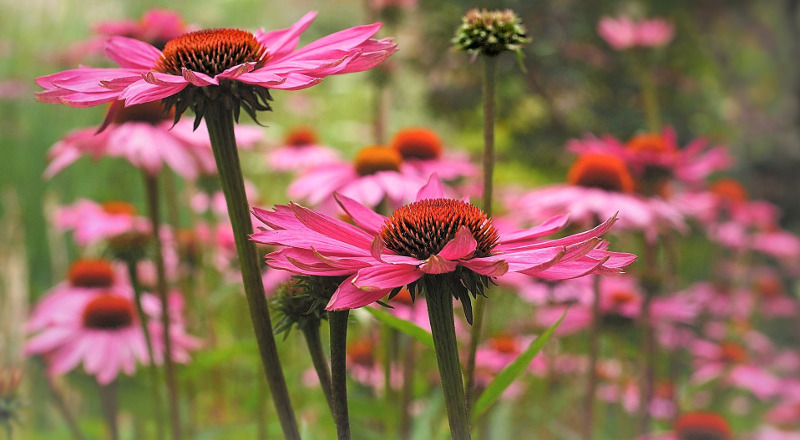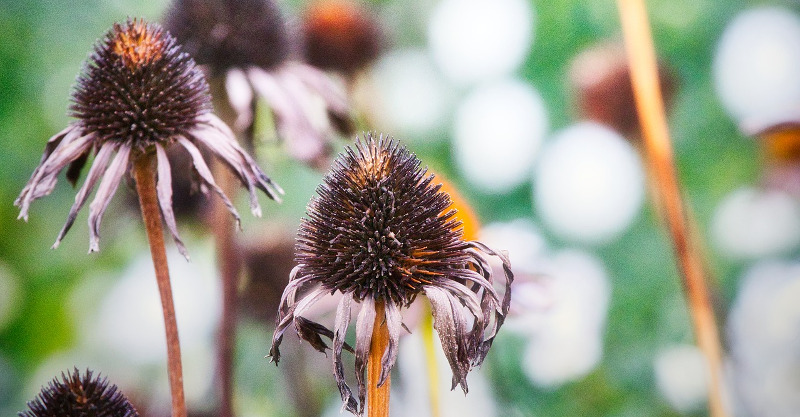Coneflower (Echinacea) are a group of native plants that are very hardy and easy to grow. These beautiful flowering perennials come in several different colors and are typically 1-3 feet tall. The plants grow in zones 3 to 9 and are native to North America. Because these plants are native, it means that it is very easy to care for them and have beautiful looking plants year after year with minimal maintenance. We do have some recommendations to ensure the coneflowers you have are the best performing plants and reach their full potential.

Planting Coneflowers
Be sure to choose a location that gets full sun and the soil drains well. The best time to plant coneflower is in the spring, but you can plant throughout the year with extra precautions. We recommend applying a layer of mulch to help protect the roots and to provide additional nutrients to the soil.
Watering Coneflowers
When planting, be sure to water regularly to help get the plants established. The top 2 inches of soil should be completely dry between waterings. Coneflower hate to stay wet, so be careful not to over-water! The plants are native and very drought tolerant once established. So little extra water needs to be provided. If the leaves are droopy, that is a good sign that the plant needs water.
Pruning Coneflowers
In the winter, you can trim the plant back all the way to the ground. We recommend leaving the dried up flowers and plants there though, as they are beneficial to the local wildlife over the winter.
Deadheading Coneflowers
You can deadhead coneflowers after the flowers die and shrivel up. You can do this throughout the summer and early fall. To do this, cut the flower back cut it from about 1/4 inch above the closest flower bud.

Fertilizing Coneflowers
We recommend adding a layer of compost underneath the mulch each spring. Simply move the mulch to the side, add the compost/manure to the dirt and mix it in really well around the plant. Then move the mulch back over to cover the dirt up. That should ensure healthy looking plants that look beautiful every year. If you would like to add a chemical fertilizer that is OK, but not necessary. Read the article for more information on how to fertilize coneflowers.
Coneflower Winter Care
Most coneflower do not need any additional care in the winter. The plants are very cold hard from zones 3 to 9. Additional protection may be needed if you are growing the plants in a planter or container or if the plants are exposed to very harsh winds. But most plants should survive through the winter with no additional care.
Common Coneflower Care Questions"
Are Coneflowers Drought Tolerant?
Once coneflowers and their root systems are well established, they are tough and drought tolerant. If the leaves start to look droopy and are wilting, it's time to give them a drink.
Why Do Coneflower Leaves Turn Yellow?
Yellow leaves on a coneflower may be indicative of crown rot if your soil does not drain well, and the plant is sitting in soggy soil. Other signs may be black leaves or foliage that presents with a deformed shape.
Do Coneflowers Come Back Every Year?
Coneflowers are perennials, meaning they do come back every year.
Do Coneflowers Spread?
Coneflowers grow in clumps and while the individual clumps may get larger, they do not spread. They do self-seed ( unless you deadhead) and can provide you with new flowers next year if the birds don't get all the seeds first. The birds love these seeds!
When Do Coneflowers Emerge?
Coneflower leaves will begin to emerge early in the spring and will be followed shortly by flower stalks.
Do Coneflower Like Sun Or Shade?
Coneflowers are native to prairie lands, so they love the sunlight. They may tolerate some shade, but will really thrive in full sun!
Have a question about Coneflower? Fill out the form below and we will try and get back to your question as soon as possible. We may even feature your question in this article to help other gardeners!
 |
Author Chris Link - Published 11-13-2020 |
